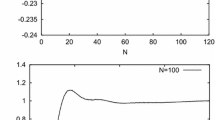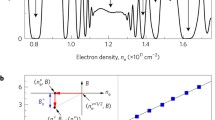Abstract
Single-wavelength Landau cyclotron orbitals (SWOs) have been used as quantum Hall basis states to reproduce integer quantum Hall plateaus in a two-dimensional (2D) close-packing representation. But at the high magnetic fields B that correspond to fractional Hall plateaus, these SWOs are too small to give close packing. It is conventionally assumed that the fractional quantum Hall states are formed from collective electron excitations (CEEs). However, by invoking the use of multiple-wavelength Landau orbitals (MWOs), we can close-pack the fractional Hall plateaus in the same manner as the integer plateaus. Quantum Hall plateaus are characterized by the filling fractions ν≡n e/n φ=k/m, where k=1, 2,... (all integers) and m=1, 3,... (all odd integers), and where n e and n φ are the 2D electron e and magnetic flux φ=h/e densities, respectively. A composite particle (CP) is a bound state of an electron and m flux quanta φ. If m is even or odd, the CP is a composite fermion (CF) or composite boson (CB). In the CEE models, both CF and CB formalisms have been used. In the alternative MWO approach introduced here, the close-packed MWOs on a ν=k/m plateau each contain m de Broglie wavelengths λ. Each MWO traps mφ external flux quanta, produces mφ diamagnetic induced flux quanta, and carries the filling fraction ν, which accounts for the extreme accuracy (one part in 108) of the Hall plateau conductance, σ H=ν e 2/h. Since m is odd, these MWOs are CB states, and they form a boson condensate of close-packed composite boson (CPCB) states. The m=1 (m<1) CPCBs tile the integer (fractional) Hall plateaus. The filling fraction index k corresponds to k layers of CPCB orbitals. Plateau formation itself is due to the linear B dependence of the density of CPCB states. The CPCBs are decoupled from the semiconductor substrate, and hence may have large m* effective mass values. THE MWOs near the ν=1/2 non-plateau region are m=2 CF states.
Similar content being viewed by others
REFERENCES
K. von Klitzing, G. Korda, and M. Pepper, Phys. Rev. Lett. 45, 494 (1980).
D. C. Tsui, H. L. Stormer, and A. C. Gossard, Phys. Rev. Lett. 48, 1559 (1982).
R. B. Laughlin, Rev. Mod. Phys. 71, 863 (1999).
M. Janssen, O. Viehweger, U. Fastenrath, and J. Hajdu, Introduction to the Theory of the Integer Quantum Hall Effect (VCH, Weinheim, 1994).
J. H. Davies, The Physics of Low-Dimensional Semiconductors (Cambridge University Press, New York, 1998).
C. L. Kane and M. P. A. Fisher, Phys. Rev. Lett. 72, 724 (1994).
Y. Imry, Introduction to Mesoscopic Physics (Oxford University Press, New York, 1997), p. 165.
S. Kivelson, D.-H. Lee, and S.-C. Zhang, Sci. Amer. 274(3), 86 (1996).
The relationship between the statistics of an electron-plus-magnetic flux CP “bound state” and the number of flux quanta φ = h/e in the CP can be thought of as follows: Pauli's spin-statistics theorem states that bosons (fermions) have integral (half integral) spin. The Ehrenrest-Oppenheimer-Bethe rule states that a composite particle is bosonic (fermionic) if the number of elementary fermions in it is even (odd). If we assume that a bound flux quantum φ (or the vortex associated with it) behaves like a spin 1/2 fermion, as does the electron, then identifying odd-φ CPs as composite bosons (CBs) and even-φ CPs as composite fermions (CFs) satisfies both the Pauli theorem and the EOB rule. We can provide a basis for regarding φ as a spin 1/2 fermion by citing Dirac's observation that an elementary particle or quantum state must have a spin of 1/2 if its position is an observable [P. A. M. Dirac, The Principles of Quantum Mechanics, 4th ed. (Clarendon, Oxford, 1958), p. 267.] This result was pointed out to the author by a referee of this paper.
S. M. Girvin and A. H. MacDonald, Phys. Rev. Lett. 58, 1252 (1987).
J. K. Jain, Phys. Rev. Lett. 63, 199 (1989).
O. Heinenon, ed., Composite Fermions: A Unified View of the Quantum Hall Regime (World Scientific, Singapore, 1998). S. D. Sarma and Aron Pinczuk, eds., Perspectives in Quantum Hall Effects (Wiley, New York, 1997).
J. K. Jain, Phys. Today 53(4), 39 (2000).
H. L. Stormer, Rev. Mod. Phys. 71, 875 (1999).
H. Aoki, Rep. Prog. Phys. 50, 655 (1987), p. 665.
M. E. Cage in The Quantum Hall Effect, R. E. Prange and S. M. Girvin, eds. (Springer, New York, 1987).
J. D. Jackson, Classical Electrodynamics, 2nd edn. (Wiley, New York, 1975).
C. P. Collier et al., Science 277, 1978 (1997); Physics Today, Dec. 1997, p. 9.
D. Weiss et al., Phys. Rev. Lett. 66, 2790 (1991). W. Kang et al., Phys. Rev. Lett. 71, 3850 (1993).
V. J. Goldman, B. Su, and J. K. Jain, Phys. Rev. Lett. 72, 2065 (1994).
R. L. Willett, K. W. West, and L. N. Pfeiffer, Phys. Rev. Lett. 75, 2988 (1995).
The Hall plateau at v = 5/2, which is outside of the present systematics, now seems to be well-established experimentally; see D. C. Tsui, Rev. Mod. Phys. 71, 891 (1999).
Author information
Authors and Affiliations
Rights and permissions
About this article
Cite this article
Mac Gregor, M.H. A UNIFIED QUANTUM HALL CLOSE-PACKED COMPOSITE BOSON (CPCB) MODEL. Found Phys Lett 13, 443–460 (2000). https://doi.org/10.1023/A:1007880715548
Published:
Issue Date:
DOI: https://doi.org/10.1023/A:1007880715548




